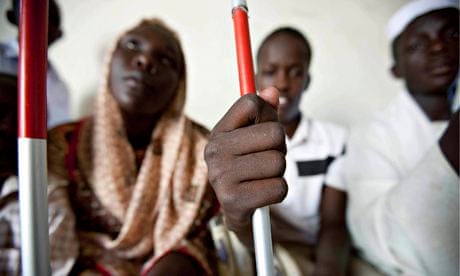Beyond the lack of access to support and assistive device, stigma also leads family members to sometimes hide away people with disabilities, making them invisible to humanitarian organisations. Without proactive measures, they are excluded from emergency care.
According to the recent World Report on Disability, 15% of the population worldwide have a disability, and 80% of those live in developing countries. With the UN Convention on the Protection and Promotion of the Rights and Dignity of Persons with Disabilities (UNCRPD), inclusion is no longer a mere desirable and ideal situation, but a requirement of international law. Here are 12 steps to including people with disabilities in humanitarian aid provision:
1. Recognise that people with disabilities are the key experts on inclusion
Encourage people with disabilities to assume responsibilities and to be subjects, not objects, of humanitarian intervention. Be proactive in this because stigmatisation and discrimination can lead to underestimation of capabilities. Recruiting staff members with disabilities to your team can help.
2. Gather data
Make sure that community mapping includes people with disabilities. It is important to identify the specific services available in the area. Identify barriers faced in accessing project activities and humanitarian action.
3. Accessible early warning systems and inclusive evacuation plans
To be prepared for a disaster is to be informed. Inaccessible warning systems and evacuation plans can cost lives. People who are deaf or hearing impaired require visual signals, while those with visual impairments require acoustic signals. For people with intellectual impairments, use messages in plain language and the assistance of caregivers and voluntary staff.
4. Accessible safe shelter
Use universal design (products and environments to be usable by all people) and include people with disabilities in construction to get advice on accessibility. If the safe shelter already exists and is not accessible, try to find creative solutions to overcome the barriers. For example, if the existing safe shelter cannot be accessed by people with physical impairments, don't give up, identify volunteers in the community who could help the individuals to access it.
5. Train search-and-rescue teams and volunteers
Raise awareness in your search-and-rescue teams of people with disabilities, their rights and the barriers they face in emergencies. Emergency staff should identify people with disabilities during community outreaches.
6. Distribution
Consider separate queues for distribution of food, water and non-food items. Where this is not feasible, prioritise persons with injuries or disabilities, establish support networks or organise door-to-door distribution. Children with disabilities are often excluded from education and may not benefit from food programmes channelled through schools. Prevent deterioration of impairments by providing appropriate drugs for epilepsy, diabetes and hypertension, for example. Handouts of assistive devices are helpful to restore mobility and independence.
7. Cash transfers and food for work
If your organisation favours cash transfers or food/cash-for-work approaches instead of handouts, include disability in the beneficiary selection criteria. Keep an amount (about 5%) of funds as unconditional transfer for the most vulnerable or look for tasks that are appropriate for people with disabilities.
8. Water, sanitation and hygiene
Make sure water points or distribution services are accessible. Ensure that water pumps are built using universal design, including an extended handle and a pump platform that is large enough to be accessed with a wheelchair or crutches. Accessible latrines include handrails and large doors (80cm width) and are on ground level or have a ramp.
9. Protection
People with disabilities are at a disproportionally high risk of maltreatment, including sexual abuse and domestic violence. Ensure that emergency shelters guarantee improved safety through selection of location and appropriate lighting.
10. Reunification
The physical and psycho-social wellbeing of people with disabilities may heavily depend on a carer, and separation from caregivers might increase the risk of abuse. Prioritise people with disabilities and carers in reunification activities or develop a support network of volunteers.
11. Don't rebuild barriers
Make sure people with disabilities are included in all your recovery and reconstruction activities. Cost effectiveness is often taken as an excuse for engaging in inaccessible construction. According to Handicap International, the extra cost of making accessible buildings can be as low as 0.5 – 1% of the total cost of a project.
12. Make livelihood opportunities equal
The need to recover from the economic effects of a disaster is common to all people affected. In situations of scarcity and competition for income, the likelihood of discrimination is heightened. Include people with disabilities in livelihood recovery strategies such as micro-credit schemes and vocational trainings.
Johanna Mang is programme director at Light for the World Austria. Follow @lftworldwide on Twitter
Join the community of global development professionals and experts. Become a GDPN member to get more stories like this direct to your inbox

Comments (…)
Sign in or create your Guardian account to join the discussion